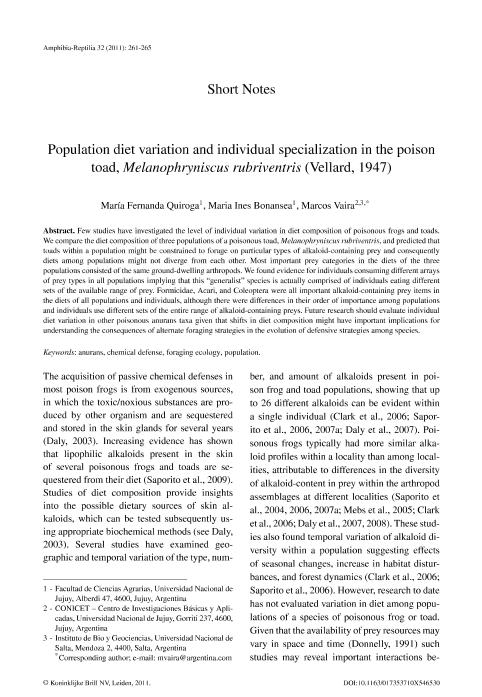Artículo
Population diet variation and individual specialization in the poison toad, Melanophryniscus rubriventris (Vellard, 1947)
Fecha de publicación:
01/2011
Editorial:
Brill Academic Publishers
Revista:
Amphibia-Reptilia
ISSN:
0173-5373
Idioma:
Inglés
Tipo de recurso:
Artículo publicado
Clasificación temática:
Resumen
Few studies have investigated the level of individual variation in diet composition of poisonous frogs and toads. We compare the diet composition of three populations of a poisonous toad, Melanophryniscus rubriventris, and predicted that toads within a population might be constrained to forage on particular types of alkaloid-containing prey and consequently diets among populations might not diverge from each other. Most important prey categories in the diets of the three populations consisted of the same ground-dwelling arthropods. We found evidence for individuals consuming different arrays of prey types in all populations implying that this "generalist" species is actually comprised of individuals eating different sets of the available range of prey. Formicidae, Acari, and Coleoptera were all important alkaloid-containing prey items in the diets of all populations and individuals, although there were differences in their order of importance among populations and individuals use different sets of the entire range of alkaloid-containing preys. Future research should evaluate individual diet variation in other poisonous anurans taxa given that shifts in diet composition might have important implications for understanding the consequences of alternate foraging strategies in the evolution of defensive strategies among species.
Palabras clave:
ANURANS
,
CHEMICAL DEFENSE
,
FORAGING ECOLOGY
,
POPULATION
Archivos asociados
Licencia
Identificadores
Colecciones
Articulos(IBIGEO)
Articulos de INST.DE BIO Y GEOCIENCIAS DEL NOA
Articulos de INST.DE BIO Y GEOCIENCIAS DEL NOA
Citación
Quiroga, Maria Fernanda; Bonansea, Maria Ines; Vaira, Marcos; Population diet variation and individual specialization in the poison toad, Melanophryniscus rubriventris (Vellard, 1947); Brill Academic Publishers; Amphibia-Reptilia; 32; 2; 1-2011; 261-265
Compartir
Altmétricas




